How Much Will Dairy Revenue Protection Cost?
TOPICS
Risk Management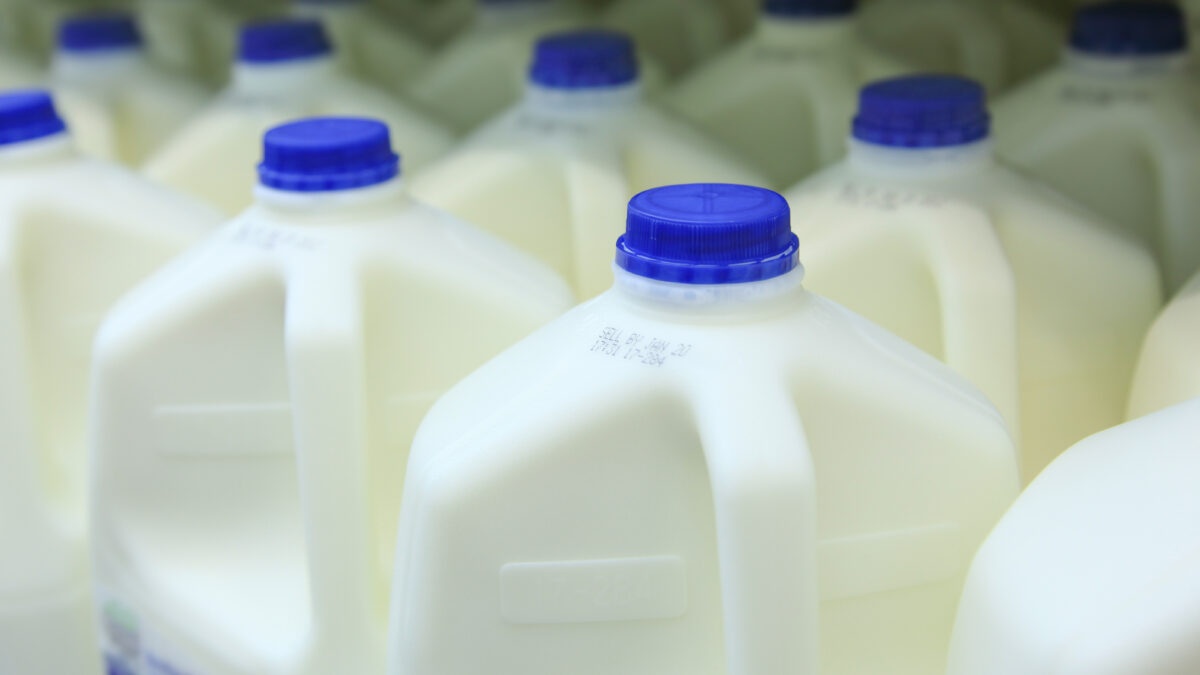
photo credit: Getty
John Newton, Ph.D.
Former AFBF Economist
Dairy Revenue Protection is an area-based quarterly revenue insurance product designed to protect against quarterly declines in revenue from milk sales. Recognizing that every farmer in the U.S. is paid a different price for their milk, Dairy-RP is unique in its ability to closely match farm-level milk price risk by providing milk pricing options based on either classified milk prices or the value of the components in the milk, i.e., butterfat and protein.
Several articles have been written reviewing how Dairy-RP was developed and how it is designed to operate: What is Dairy Revenue Protection? and Dairy Revenue Protection is Here. One of the few remaining unanswered questions about the product is how much will Dairy-RP plans cost? Today’s article provides example Dairy-RP premium rates for a variety of coverage options based on CME futures and options as of Oct. 4. Premiums will be slightly different when Dairy-RP launches Oct. 9.
Class Pricing Option
Under the Class Pricing Option, Dairy-RP provides revenue protection based on a combination of Class III and Class IV milk futures prices. The producer can choose the weight on Class III used to establish their price guarantee per hundredweight. The weighting factor ranges from 0 to 100 percent on Class III. This weighting factor allows Dairy-RP to better align with the utilization of milk in a farmer’s marketing area and tailors the risk management coverage to business risk exposure.
For example, assuming Dairy-RP were available for sale as of Oct.5-- based on Oct. 4 futures settlement prices for Class III and Class IV milk, a dairy farmer could choose to protect revenue from $15.19 per hundredweight to $15.80 per hundredweight during the first quarter of 2019. For the fourth quarter of 2019, prices are available from $16.11 to $16.32 per hundredweight. Figure 1 identifies the range of class prices available assuming Dairy-RP were available today.
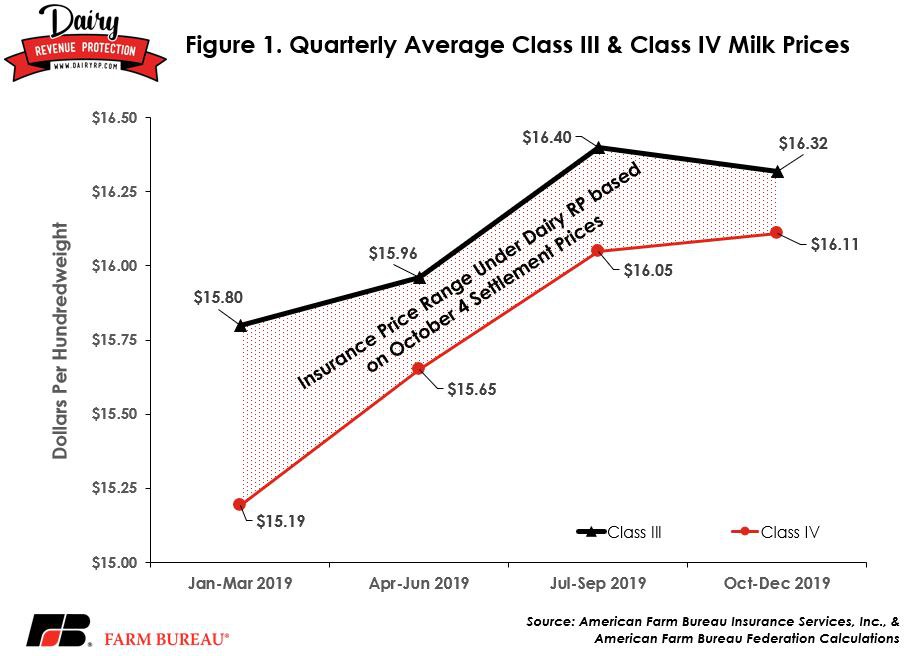
The cost of Dairy-RP will vary daily based on the state and policy declarations, e.g., coverage level or class price weighting factor, as well as on the futures market prices and option-implied risk, and finally, the expected yield deviation for state-level or pooled production region milk production per cow.
Based on CME futures prices as of Oct. 4, and assuming a 95 percent coverage level and 50 percent class price weighting factor, producer premium rates in Wisconsin range from a low of 11 cents per hundredweight for January to March 2019 to 26 cents per hundredweight for the October to December 2019 insurance period. In California, premiums for a similar policy and coverage periods range from 13 cents per hundredweight to 36 cents per hundredweight.
In general, premiums under Dairy-RP will be more affordable for lower coverage levels and for more nearby quarters. Premiums will get more expensive for deferred insurance policies such as the fourth or fifth nearby quarter because the uncertainty in the market is higher. In each of the examples of Dairy-RP premiums, a 44 percent premium subsidy associated with the 95 percent coverage level is included. Figure 2 highlights Dairy-RP premium rates for several states for the next four nearby quarters.
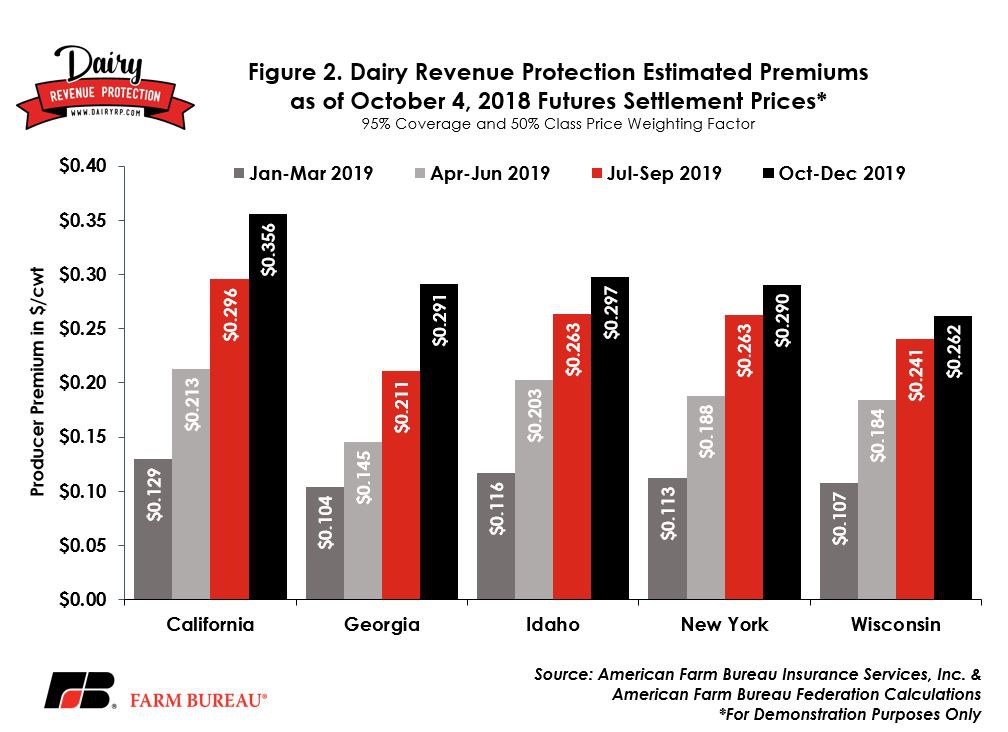
Why Different Premiums by State?
The regression models used to determine state-level or pooled production region expected milk yields use publicly available information and appropriate statistical methods.
Differences in premiums between states are due to two factors: different yield standard deviations from the regression models; and the different degree to which yield shocks are correlated to shocks in prices.
States with higher yield uncertainty will have higher Dairy-RP premium rates. Additionally, states that have negative yield shocks closely correlated to price declines will see higher premium rates under Dairy-RP as the joint co-movement in prices and yield would result in a higher indemnity.
Component Pricing Option
The Component Pricing Option is revenue protection based on the components in the milk, including butterfat, protein and other solids. The producer can select the desired butterfat percentage and protein percentage. Butterfat options range from 3.5 percent to 5 percent. Protein options range from 3 percent to 4 percent. The other solids percentage is fixed at 5.7 percent. The minimum component levels closely match the Class III milk price that is based on 3.5 percent butterfat, 2.99 percent protein and 5.69 other solids.
By electing the component pricing option, a producer can increase the value of milk insured under the policy to reflect the higher-valued high-component milk. For example, the January to March average Class III milk price was $15.80 per hundredweight (and assumes a minimum 3.5 percent butterfat and 2.99 percent protein). The minimum component value for this same period would be $15.84 per hundredweight – close to the Class III value – but the maximum component value would be $21.53 per hundredweight. This $5.69 per hundredweight difference in milk value reflects the higher butterfat and protein content, and thus a higher value per hundredweight of the milk produced by the farmer.
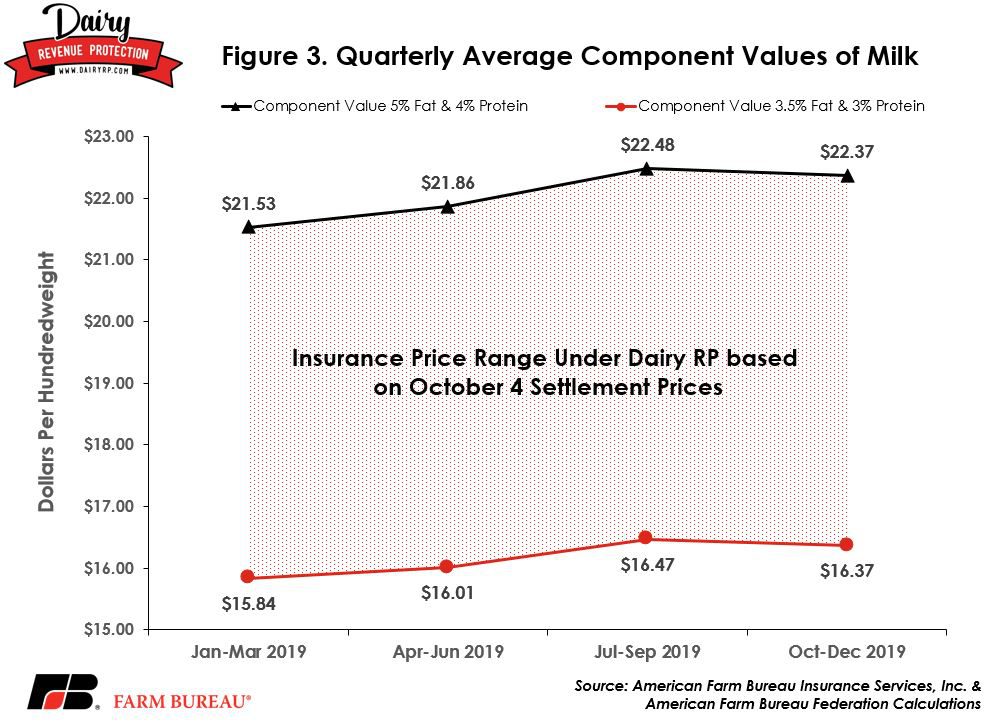
The component option will match the minimum regulated Federal Milk Marketing Order price for dairy farmers pooling in a component pricing order. Dairy farmers pooling in a component and skim-fat order could use a combination of Dairy-RP policies in a month to try to capture their risk exposure.
Since the component pricing option is designed to insure a higher value of milk, the total policy liability and policy premium will be higher. For a Wisconsin-based policy with a 95 percent coverage level, subsidized Dairy-RP premiums ranged from 16 cents per hundredweight to 39 cents per hundredweight for the maximum component level policy. For a lower component level option of 4 percent butterfat and 3.2 percent protein, premiums ranged from 14 cents per hundredweight to 32 cents per hundredweight.
Figure 4 highlights examples of Dairy-RP premium rates for a component pricing option policy based on current market price and risk expectations.
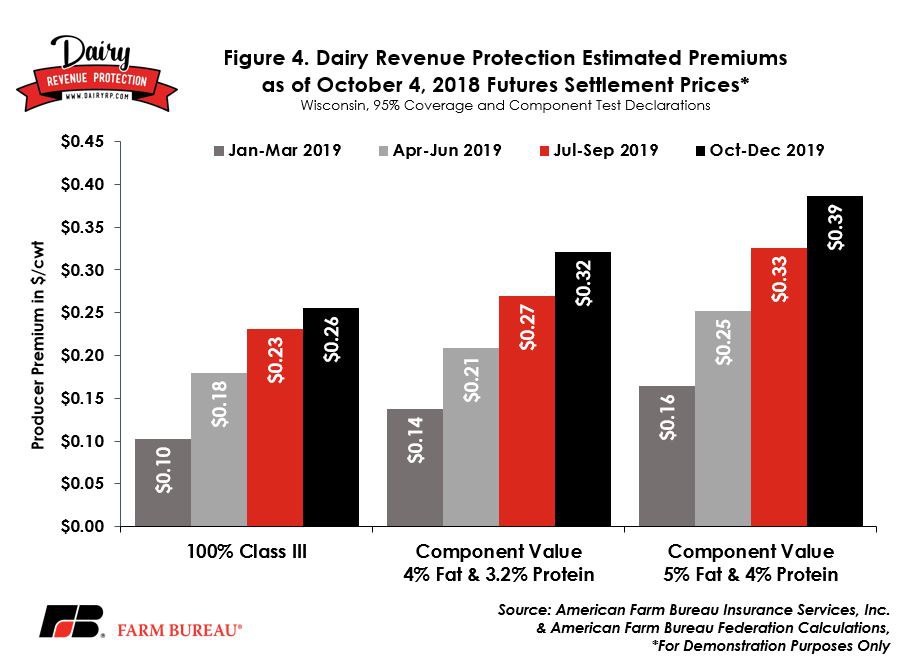
Summary
One of the most frequently asked questions during the development of Dairy-RP has been: How much will it cost? The answer is: It depends. While premiums will change based on the risk environment, the most important aspect of the policy is that both coverage and premiums are actuarially appropriate. Prices will change daily based on the market, and premiums will change daily based on the farmer’s insurance declarations and expected risk around milk and dairy commodity prices. Importantly, all dairy farmers electing similar coverage options will have the same per hundredweight premium rate and there is no limit on how much milk can be insured.
Early indications are that higher levels of Dairy-RP coverage are indeed affordable and could range from 10 cents to 30 cents per hundredweight depending on the quarter insured. More nearby quarters will be more affordable than distant quarters, and policies with higher deductibles or lower values of milk insured will be more affordable – albeit at the expense of less risk management protection. When combined with USDA Farm Service Agency’s improved Margin Protection Program, dairy farmers will have a robust USDA-sponsored safety net.
While the premiums presented here are for demonstration purposes only, getting a real-time quote is easy with American Farm Bureau Insurance Services, Inc. Beginning Oct. 9, farmer-customers with AFBIS-affiliated Farm Bureau insurance companies will have access to a real-time mobile application dedicated to Dairy-RP.
The app is available for download on the iTunes store.
Trending Topics
VIEW ALL